S4X (1.1) Reference
back to OLLO Audio
back to measurements
home
published: May-15-2022, updated July-08-2022
NO SMOOTHING is applied to the shown plots. Most measurement sites have some smoothing applied which ‘irons flat’ sharp peaks and ‘wiggles’. I do not use smoothing because some info about sound quality is lost when plots are smoothed.
Aside from a small correction of the microphone itself also some correction in the lowest frequencies is applied to the plots to compensate for the perceived loss of bass when using headphones. This is described HERE in more detail.
A ‘horizontal‘ frequency response curve on the shown frequency response plots on this website thus indicates a perceived ‘flat’ tonal signature.
ALL measurements are made with a good SEAL on a flatbed measurement rig.
The shape of your head, bone structure, pad size, pad ‘softness, (compliance), hair or no hair and or wearing glasses may (drastically) change the frequency response of some headphones, so… your personal experience may differ substantially from these plots.
Frequency response (tonal balance) is the most sound-determining aspect of headphones. A horizontal line shows audible neutral response in the plots on this website. Deviations in different severities at different frequency bands have an effect on the sound character.
The bigger the deviation the stronger the effect.
Below an aid to help determining the sound character of headphones with relation to the frequency response.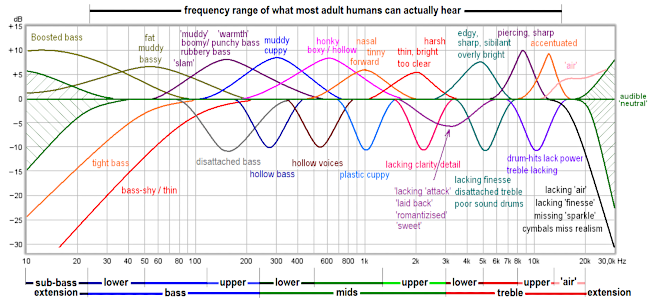
OLLO Audio S4X Reference (1.1)
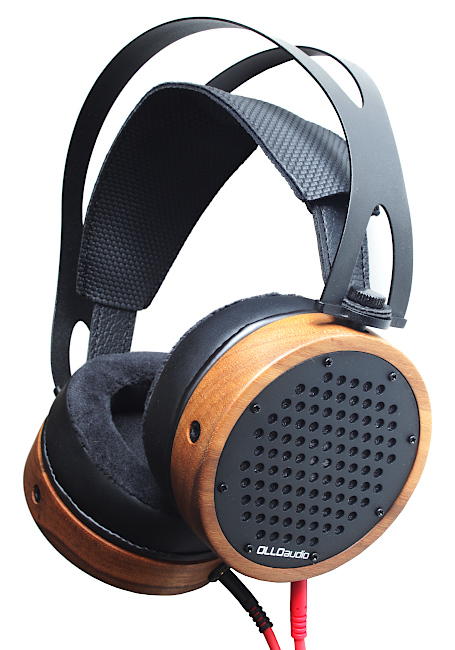
The OLLO Audio S4X Reference (1.1) is a semi-open over-ear dynamic headphone.
It sells for € 399.- but one can also buy a one with very minor cosmetic flaws (same audio quality/warranty) for € 299.- directly from the manufacturer but is also available in some web shops.
The S4X Reference is designed for mixing/mastering and music reproduction.
OLLO Audio is a small Slovenian company founded in 2017 and is focused on headphones for studio usage and currently offer 2 models. The open S4X Reference (1.1) and the closed S4R (1.1).
On top of that, materials used are very durable, metal, leather, wood. Even the packaging is all durable and made completely without plastic.
These come with a 5-year warranty.
Weighing 393 gram this isn’t one of the lightest headphones around. Clamping force is higher than average (5.5N) but can be lowered by bending the steel headband.Fortunately due to the soft and wide headband and the large contact area of the pads on the skin the weight and clamping force is still comfortable.
The headband is made of painted steel. There is a leather strap with an elastic band inside which makes it self-adjusting. The metal parts are very microphonic when touching them and tapping on them resonates for a second or so. Once on the head and seated there is no need to touch the headband so not an issue during usage.
The pads are hybrid type so different materials were used. The surface that makes contact with the skin is velour. The outer and inner side is pleather (PVC leather). The pads are not angled and 21mm deep.
The inner diameter is a rather small 51mm which means people with larger pinnae will find the earlobes pressed against the pads. The foam inside is fast memory foam and feels quite firm. The pads are removable and fitted onto a metal baffle with a handy cut-out. This allows the pads to be changed easily simply by rotating them all the way around.
The cups only have a very limited swivel (as good as none) but can rotate 360 degrees (without a cable attached to it) and fold flat. The latter is handy for transport and lying them on a desk. The cups are made of wood and the crafting of it is very nice. It does fit well on my average sized head and can get good seal (which is very important for this headphone) despite the small swivel of the cups.
There is a non-locking 2.5mm TRS socket in each cup. When the cable is janked the plugs come out but fit snugly enough so that they don’t fall out easily.
It requires some force to adjust the cups to their proper position. When the headphone is taken off the cups stay in that position. I have no idea how long it stays this way.
Each headphone comes with a certificate of authenticity and a measurement plot (of both cups combined) measured on an industrial test fixture (GRAS 45CC + RA0039). There is also a pdf with much more measurements and comparisons.
With a quite high sensitivity of 115dB/V (efficiency = 100dB/mW) and low impedance (32Ω measured) this headphone plays loud even directly from a phone. This means that it will also play loud directly from (cheaper) audio interfaces and instruments. There is no need for powerful amps.
The supplied (black) cloth covered cable is 1.6m up to the cable slitter and continues as 2 separate 0.4m red smooth cables, so in total it is 2m in length. The cable is microphonic so touching the cable is audible in the headphone. The connectors come out of the cups with a small forward angle (or backward if so desired) so the cable drapes in front (or back) of the listener.
The cable is terminated in a straight gold plated 3.5mm TRS plug with a 6.3mm screw-on adapter). On the headphone side there are 2.5mm TRS plugs with red and black connectors indicating left and right. There are no L and R markings found on the headphone nor the cable.
All in all this headphone feels and looks very sturdy and durable and is made with respect for mother nature.
While this headphone is intended for the studio market I would say this headphone also is great for hi-fi music reproduction for people who do not prefer the Harman target but like headphones like the DT990 but without the sharp treble or other, not too warm, sounding headphones.
The high sensitivity/efficiency makes this headphone very suited to be driven with low output power portable sources such as phones, small DAPs, laptops, tablets for indoor music enjoyment.
The S4X 1.2 has slightly less treble than the reviewed S4X (1.1). The S4X 1.3 is the same as the 1.2 but comes with a calibration file that can be used with a DAW improving the response just a little bit more.
specifications:
Type: over ear (circum-aural), semi-open
Usage: studio, home
Driver type: dynamic
Pads: replaceable hybrid (pleather + velour) with memory foam
Collapsible: no, but folds flat
Headphone cup connector: 2x 2.5mm TRS
Cable entry: dual sided.
Cable: 2m terminated in a gold-plated 3.5mm TRS jack with screw-on 6.3mm adapter
Inner Pad dimensions: depth = 21mm, diameter = 51mm.
Driver size: 45mm
Nom. power rating: 0.5W (estimated)
Max. voltage: 4Vrms (11Vpp)
Max. current: 125mA
Max. S.P.L.: 130dB
Impedance: 32Ω (measured)
Efficiency: 100dB @ 1mW
Sensitivity: 115dB @ 1V (specs state 108dB/V @1kHz)
Weight: 393 g. (without cable)
Clamping force: high (5.5N)
Accessories: 6.3mm adapter, carrying pouch, manual, documentation.
Subjective sound description:
Bass is present and of excellent quality with good bass extension. Integration from bass to mids is seamless and very natural/realistic. Bass extension is there but bass-heads will be sorely disappointed.
On well made recordings with plenty of deep lows the bass sounds excellent.
The mids sound powerful, dynamic and is free of distortion, even at very high listening levels. The mids have a warm/full character. The sound signature is on the warm side.
Treble is not silky smooth but still of good quality. No sibilance nor sharpness, merely a slight ‘metalic’ edge on some music. The frequency response starts to drop gently from 12kHz upwards yet does not sound rolled-off but does lack some ‘air’ and finest ‘nuances’ in the treble.
This headphone sounds like small good speakers in a room but with well extended sub-bass and capable of high SPL.
Those that want thunderous bass can EQ the lows and the headphone responds very well to this.
Measurements:
Below the frequency response of the S4X (Left, Right) The channel matching is excellent. Bass extension is also excellent but requires a (near) perfect seal. Up to 1kHz the response is sloping downwards by 5dB giving the mids a warm/full character. From 1kHz to 5kHz the response is very flat. Treble starts to roll-off above 18kHz.
The channel matching is excellent. Bass extension is also excellent but requires a (near) perfect seal. Up to 1kHz the response is sloping downwards by 5dB giving the mids a warm/full character. From 1kHz to 5kHz the response is very flat. Treble starts to roll-off above 18kHz.
compared to
Below the closed S4R (1.1) versus the open S4X.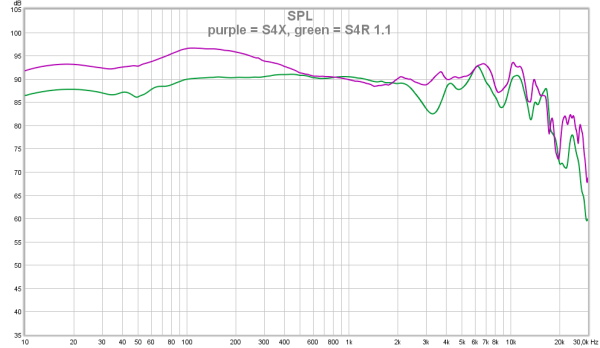 The S4X is warmer and fuller sounding than the closed S4R (1.1) with (seemingly) less brightness.
The S4X is warmer and fuller sounding than the closed S4R (1.1) with (seemingly) less brightness.
As the S4X Reference is a headphone intended for studio usage below some comparisons with some other headphones that have a similar purpose.
The best known reference may well be the Sennheiser HD650 which is known for its warm neutral/natural sound.  The S4X is warmer and better extended in the bass compared to the HD650. From 600Hz to 12kHz the response is very similar. Above 12kHz the S4X starts to roll-off slightly where the HD650 goes on to at least 30kHz.
The S4X is warmer and better extended in the bass compared to the HD650. From 600Hz to 12kHz the response is very similar. Above 12kHz the S4X starts to roll-off slightly where the HD650 goes on to at least 30kHz.
Below the S4X vs the Sennheiser HD400 Pro (=HD560S)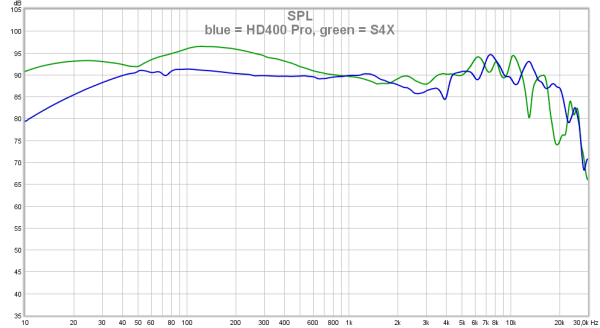
The HD400 Pro (= HD560S) is more neutral but starts to roll-off below 30Hz where the S4X reaches 10Hz.
Both headphones are a little elevated above 5kHz but as the S4X has more lows/lower mids this is more apparent in the HD400 Pro.
Tonal balance wise the S4X has more similarities in the Beyerdynamic headphone line.
Below the S4X versus the TYGR 300R. The TYGR 300R has a similar bass response but starts to roll-off below 40Hz where the S4X reaches deeper. Another difference is found above 5kHz where the TYGR 300R has a lot more treble but is also better extended.
The TYGR 300R has a similar bass response but starts to roll-off below 40Hz where the S4X reaches deeper. Another difference is found above 5kHz where the TYGR 300R has a lot more treble but is also better extended.
Below the most well known open Beyerdynamic DT990 headphone compared to the S4X.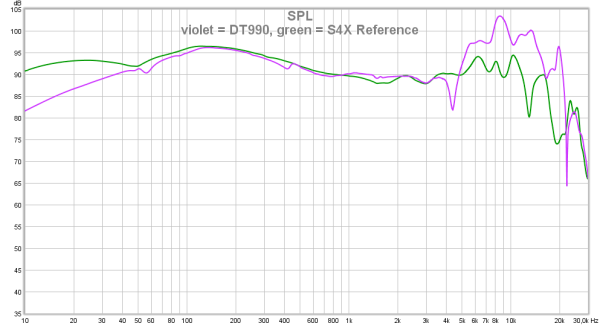 Those looking for a DT990 alike sound but without the piercing treble and even better bass extension could look into the S4X.
Those looking for a DT990 alike sound but without the piercing treble and even better bass extension could look into the S4X.
Another lesser known Beyerdynamic headphone is the Amiron Home.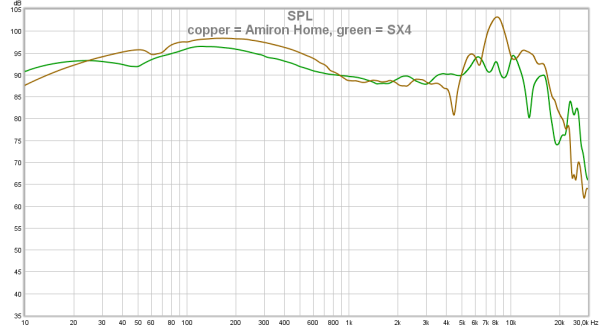 The Amiron home has a similar bass extension but is also a lot ‘warmer’ sounding bordering on having a muddy sound. Also the well known ‘mount Beyer’ treble peak stands out. The S4X is closer to neutral and does not have fierce treble.
The Amiron home has a similar bass extension but is also a lot ‘warmer’ sounding bordering on having a muddy sound. Also the well known ‘mount Beyer’ treble peak stands out. The S4X is closer to neutral and does not have fierce treble.
A Beyerdynamic in a similar price range is the DT1990 Pro. This one comes with 2 different pads so the owner can choose between 2 different tonal characters.
Below the DT1990 with Balanced pads versus the S4X.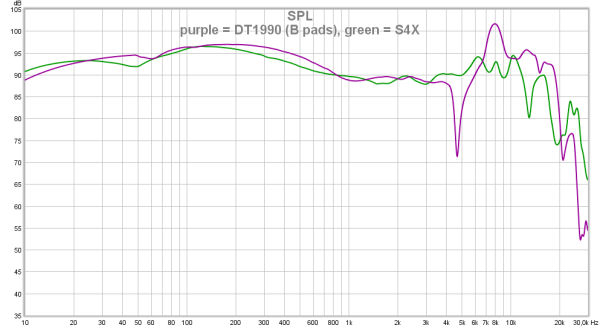 Bass response is very similar to the DT1990-B but the Beyerdynamic is a bit warmer tilted with fierce treble up top.
Bass response is very similar to the DT1990-B but the Beyerdynamic is a bit warmer tilted with fierce treble up top.
The DT1990 can also be fitted with Analytical pads which is shown below.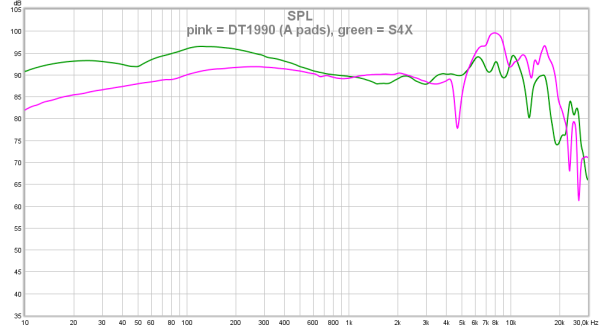 The DT1990-A is more neutral in the lows and actually closer to the S4R (1.1) in tonal balance than it is to the S4X.
The DT1990-A is more neutral in the lows and actually closer to the S4R (1.1) in tonal balance than it is to the S4X.
Except the treble of course which is at a much better level in both the S4R (1.1) and S4X.
A more expensive Beyerdynamic is the T1 mkII (now replaced by the mkIII)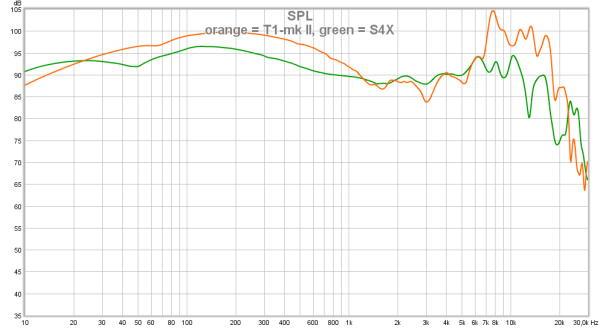 The S4X is much closer to neutral and does not have the severely elevated treble of the T1-mkII.
The S4X is much closer to neutral and does not have the severely elevated treble of the T1-mkII.
Then there is also the DT880 Black Special Edition which is very close to the Amiron Home.
The S4X is better extended where the DT880BSE is a bit muddy sounding with too much treble up top.
The DT880BSE is no match for the S4X.
Below the more common regular DT880 versus the S4X.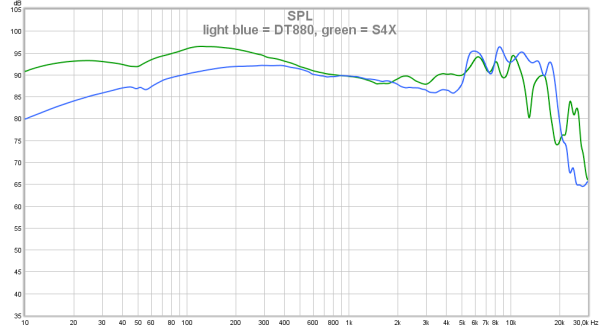 The DT880 is much leaner sounding with elevated treble. The S4X is warmer/fuller sounding with less elevated treble.
The DT880 is much leaner sounding with elevated treble. The S4X is warmer/fuller sounding with less elevated treble.
Below a similar looking but more expensive Audeze LCD-2 (Fazor) versus the S4X. The bass response of the LCD-2 is well liked and actually much closer to the S4R(1.1) than the S4X.
The bass response of the LCD-2 is well liked and actually much closer to the S4R(1.1) than the S4X.
The LCD-2 is lacking clarity and treble so darker sounding than the S4X.
In the Sennheiser range the closest in sound character to the S4X is the HD599.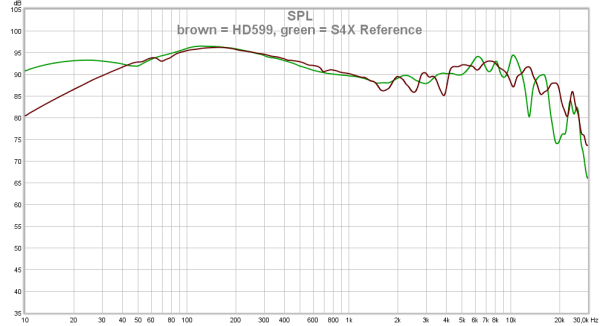 These are quite similar in sound but the S4X has better bass extension.
These are quite similar in sound but the S4X has better bass extension.
Below the MrSpeakers (now DCA) AEON Flow open vs the S4X.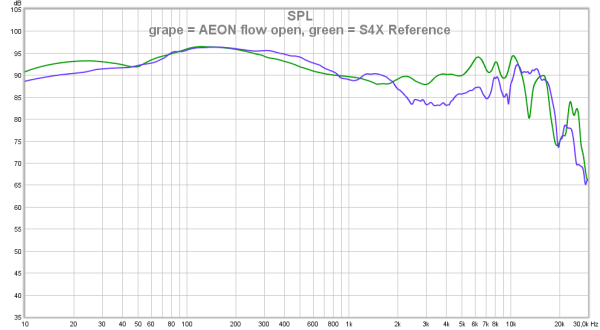 The planar AEON Flow open has a similar response below 2kHz. Above 2kHz the S4X has better clarity.
The planar AEON Flow open has a similar response below 2kHz. Above 2kHz the S4X has better clarity.
phase response
Below the phase response of the S4X (Left, Right) The teal trace is the phase response of the Sennheiser HD650 as a reference. For some reason the phase begins to alter above 6kHz. The same is seen in the S4R (1.1). As the phase change is not steep I don’t think this is really audible nor an issue but it differs from other headphones I have measured.
The teal trace is the phase response of the Sennheiser HD650 as a reference. For some reason the phase begins to alter above 6kHz. The same is seen in the S4R (1.1). As the phase change is not steep I don’t think this is really audible nor an issue but it differs from other headphones I have measured.
Only when phase shifts are substantial and are present in a narrow frequency band this could have audible consequences. The phase shift is substantial above 6kHz but not steep. One should realize that with speakers in a room the phase shifts are much bigger than this one.
output resistance / damping-factor
As this is a dynamic headphone the frequency response could be amplifier output resistance dependent.
The S4X is measured via a 4 different output resistances (0.2Ω, 10Ω, 32Ωand 120Ω). On a higher output resistance amplifier the output level will be lower of course due to voltage division. To compensate for this the amplifier is cranked up to the same level (13.8dB for 120Ω at 1kHz in this case). This way the plots are overlaid and it is easier to see how the tonal balance changes. 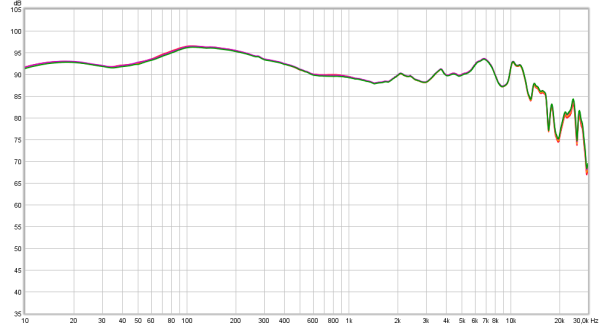 There is no tonal change when this headphone is connected to different output resistance amplifiers/outputs. This means one does not have to be worried about the ‘1/8th rule’ and this headphone will sound correct on all gear it is connected to.
There is no tonal change when this headphone is connected to different output resistance amplifiers/outputs. This means one does not have to be worried about the ‘1/8th rule’ and this headphone will sound correct on all gear it is connected to.
Linearity
While there was no reason to suspect linearity issues the S4X is measured 4 times. Once at 60dB, 70dB, 80dB, 90dB and 97dB SPL. When the traces are overlaid and have the same shape then there is no compression.  The 60dB, 70dB, 80dB, 90dB and 97dB trace are all the same shape so there is no indication of compression going on till at least 97dB SPL. This means that when one plays softly or loud the headphone will always have the same tonal balance. This is excellent.
The 60dB, 70dB, 80dB, 90dB and 97dB trace are all the same shape so there is no indication of compression going on till at least 97dB SPL. This means that when one plays softly or loud the headphone will always have the same tonal balance. This is excellent.
seal
Seal can be an issue with closed-back headphones and is generally less of an issue with open headphones. Due the acoustic design used in the OLLO headphones the open S4X is very sensitive to seal issues. Perfect seal, using thin armed glasses, thin armed reading glasses with arms that do not rest against the skin. thick armed reading glassed not resting against the skin.
Breaking the seal reduces bass extension. A small seal breach does not affect the response very much.
Larger seal breaches should be avoided.
Below the distortion measurements of the S4X (Right channel). The measurements are made at 90 dB SPL. 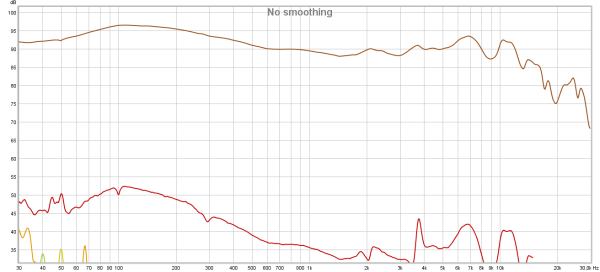 The plot above shows the level differences between the signal (upper trace) and the harmonics.
The plot above shows the level differences between the signal (upper trace) and the harmonics.
Most people prefer to see percentages instead of level differences so below the exact same plot except ‘normalized’ to the actual signal and level differences given in percentages. Distortion levels are very low and is exemplary and rivals that of planar headphones.
Distortion levels are very low and is exemplary and rivals that of planar headphones.
The actual 2nd harmonic distortion may well be lower than shown. A shortcoming of my measurement rig.
Below the CSD (waterfall) plot of the S4X (Left and Right are overlaid)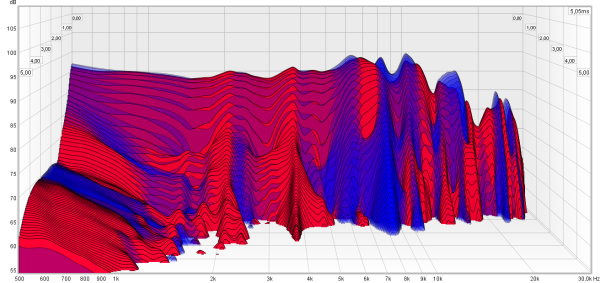 The S4X is well damped and shows excellent time response without any alarming resonances.
The S4X is well damped and shows excellent time response without any alarming resonances.
The S4R (1.1) is even better damped though.
Below the Group Delay plot for the S4X (Left, Right)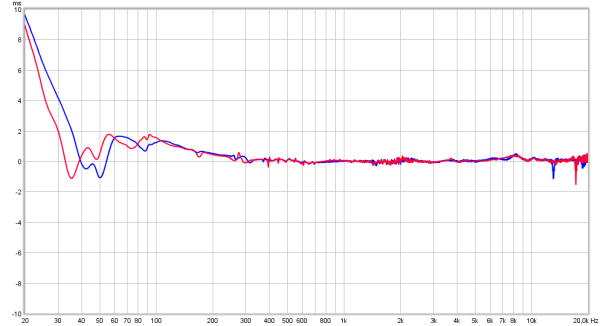 Between 30Hz and 60Hz there is a very small amount of pad bounce visible but this certainly isn’t audible. Above 100Hz the response is excellent showing no resonances.
Between 30Hz and 60Hz there is a very small amount of pad bounce visible but this certainly isn’t audible. Above 100Hz the response is excellent showing no resonances.
A different plot is the spectrum plot. This basically is a CSD (Waterfall) plot but viewed from above where the level differences are color coded instead of being in the vertical axis. Also the frequency range of the spectrum plot is wider (from 100Hz instead of 500Hz). The time span is also bigger in the spectrum plots and expired time is shown from below to top where in the CSD the time is shown from rear to front.
Below the spectrum plot of the S4X (Left channel)
No alarming resonances or lingering is visible.
Step response
Below the step response plot which, when the sound is balanced and well extended should show a fast rise to around 0dB, (indicating fast driver response) and then should be slightly sloping downwards indicating bass extension. (Left, Right) The sharp rise up to -5dB below the reached peak level indicates the driver response is well damped. There is no overshoot. The 2 peaks in the first 250μs show there is a bit excess 6kHz which indicates clarity is just a bit higher than desirable for music enjoyment. The horizontal trace barely sags indicating excellent sub-bass extension. The rise to 1ms shows the lower mids and bass is elevated a bit and is an indication of a warm/full sound.
The sharp rise up to -5dB below the reached peak level indicates the driver response is well damped. There is no overshoot. The 2 peaks in the first 250μs show there is a bit excess 6kHz which indicates clarity is just a bit higher than desirable for music enjoyment. The horizontal trace barely sags indicating excellent sub-bass extension. The rise to 1ms shows the lower mids and bass is elevated a bit and is an indication of a warm/full sound.
Drivers
Due to the construction of this headphone one should not press the headphones onto the head.
This can cause the driver to become damaged as the membrane would be pressed onto the magnet.
There is a clear warning for this in the manual but most people familiar with audio gear do not read manuals unless there are complex menus or functionality.
The advantage of the used construction is the excellent sub-bass response.
Below a picture of the rear and front of the S4X driver. The S4X has additional damping foam.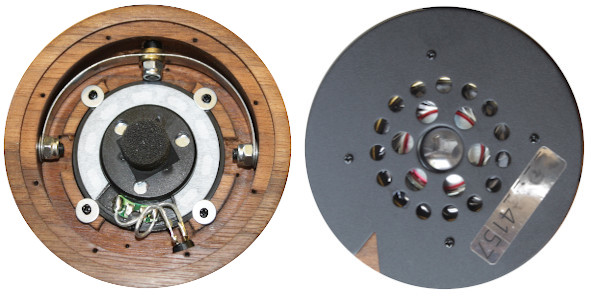 The space between the front of the driver and the head is well sealed so equalization pressure can only escape via the pads. As the rear of the driver is open the membrane can easily be pushed (or pulled) when putting pressure on the headphone which could damage the driver so some care has to be taken when putting the S4X on the head.
The space between the front of the driver and the head is well sealed so equalization pressure can only escape via the pads. As the rear of the driver is open the membrane can easily be pushed (or pulled) when putting pressure on the headphone which could damage the driver so some care has to be taken when putting the S4X on the head.
When wondering why a little corner is removed from the metal baffle, this is done so one can easily and quickly ‘rotate’ a pad onto the headphone.
Treble tweaking
The treble can be made to sound a little ‘smoother’ and while this does not improve the lack of ‘sparkle/air’ the treble quality improves a bit and the slight ‘metallic’ ringing (small peak at 10kHz) can be lowered.
This requires replacing the black thin synthetic cloth disc present between the pad (which has its own dust filter) with a single ply of a 2 (or 3)ply of toilet paper cut to the same diameter as the synthetic cloth disc. The driver itself (so without the black disc) has substantial treble peaking between 5kHz and 12kHz.
The driver itself (so without the black disc) has substantial treble peaking between 5kHz and 12kHz.
That black disc reduces the area between 5kHz and 10kHz quite substantially but at 10kHz the peak is hardly lower and peaks a bit above the mids.
(Note: measurements are of the right channel only and are smoothed 1/12 octave)
When the black disc is replaced with a single ply of a 2-ply sheet of toilet paper the frequencies above 5kHz are attenuated differently which smooths the treble a bit and removes the ‘metallic’ edge that sometimes is present in some recordings. without the black disc vs with toilet paper the difference is subtle but audible and easily reversible.
Note the plot below is with the ‘warmth filter’ (described below).
Warmth filter
As the S4X is a few dB too ‘warm’ this can be passively filtered. Below the stock S4X vs. low filtered.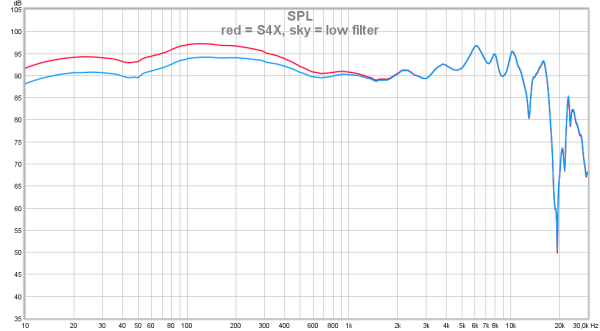 This brings the lows down by about 4dB making the sound much more balanced yet still tastefully elevated in the bass.
This brings the lows down by about 4dB making the sound much more balanced yet still tastefully elevated in the bass.
below the schematic for this filter.
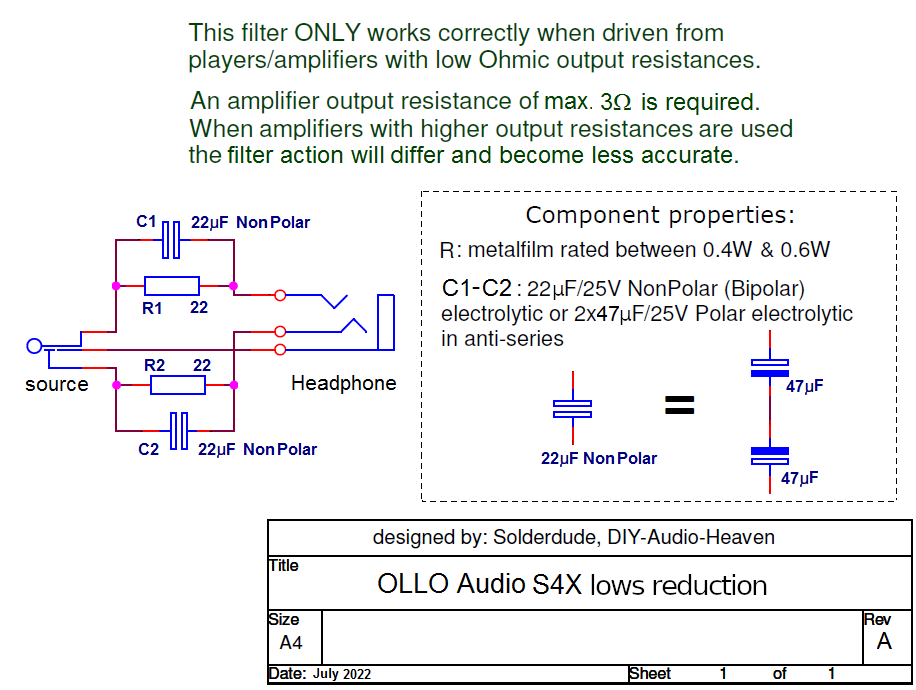
Below a picture of this modification. 
It should be noted that this filter looses its effect when amplifiers with an output resistance higher than a few Ohm are used.
There is also a Kameleon module designed for this headphone.
Below the difference between the stock S4X (1.1) Reference and via Kameleon.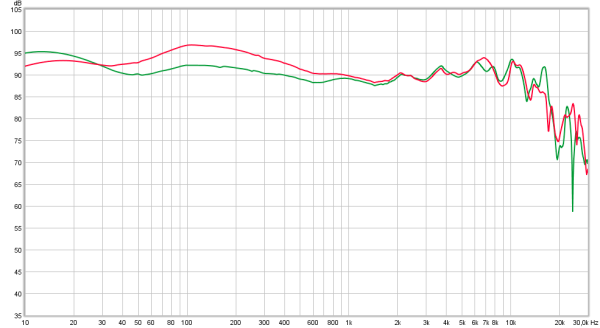 More subbass, less warmth/midbass and 7kHz peak lowered a little bit.
More subbass, less warmth/midbass and 7kHz peak lowered a little bit.
conclusion
The OLLO Audio S4X Reference (1.1) is not ‘just another headphone’ on the professional market. While this headphone is intended for the professional market specifically for mixing, mastering and playback the applicability goes beyond that specific goal. At € 399.- this isn’t a cheap headphone but offers sound quality competing and exceeding that of many much more expensive headphones.
Those looking for thumping bass should either look elsewhere or use EQ (reacts great).
While this headphone is intended for the studio market I would say this headphone also is great for high quality music reproduction for people who do not prefer the Harman target but like headphones like the DT990, but without the sharp treble or other not too warm sounding headphones.
The high sensitivity/efficiency makes this headphone very suited to be driven with low output power portable sources such as phones, small DAPs, laptops, tablets for indoor usage.
With a little bit of EQ at 6kHz and lowering the area between 50Hz and 500Hz a bit this becomes an excellent and totally non-fatiguing headphone for music enjoyment with excellent bass and smooth silky well extended highs. Very, very enjoyable and true reference sound quality.
- Those that want warm yet accurate sound (akin to the tonal balance of speakers in a room) may well be interested in the S4X
- It is an open headphone so outside noises are not attenuated much and others around you can hear what is playing.
- The OLLO headphones are very serviceable and of durable quality materials such as steel, aluminium, wood, leather and every part can be ordered if needed.
- The manufacturer is very approachable and even offers a trial arrangement, a nice carrying case and it appears an amplifier is even in the making.
- The build quality is excellent and has got the sound quality to match.
- The cups can lay flat on the desk.
- The S4X has a high sensitivity thus can play loud (with authority) from almost every device. Be careful with the volume control. It plays loud quite quickly.
- Completely insensitive to output resistances of sources so no need to worry about the sound quality degrading on some sources.
- Replaceable cable with 2 x 2.5mm TRS plugs so easy to find different length aftermarket cables. (Only Tip and Sleeve are connected)
- A closed version is also available (S4R 1.1) which has a more neutral/bass-light tone.
- 5 year (limited) warranty.
- Self-adjusting headband.
- Accurate individual frequency response measurement of each headphone provided in the box
- Sustainable materials used even for the box it comes in.
- 30-day trial period
- Hand matched (measured) drivers.
Of course there are also some niggles.
- The headband is very microphonic. As long as you don’t touch it its fine though.
- The sonic signature may be too warm for a lot of people. EQ or the filter helps.
- The clamping force out of the box is high. After a few hours I got a headache and lowered the clamping force by carefully bending the headband.
- The inner diameter of the pads is on the small side (Ø 51 mm) but has enough depth (21 mm). Larger ears thus may not completely fit (in height).
- One has to be careful not to press the headphones against the head.
- The cable is also very microphonic, touching it is audible in the cups, even with music playing.
- There is very little tilt adjust-ability so for wider heads or smaller heads it may be difficult to get a good fit/seal. Seal is quite important for this headphone when bass extension is important.
- The S4X has a fair bit of weight to it, mostly because of the usage of sturdy (not plastic !) materials.

Ollo Audio is a small SlovEnian company… Aloha
corrEcted !
thanks